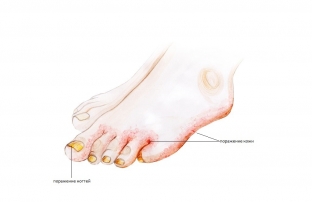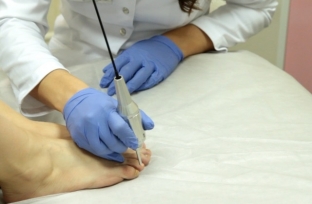All human fungal diseases are infectious in nature and most often affect the skin and nails. The danger of the fungus lies in its vitality and stability. There are many different ways to eradicate such a problem, but only a few are truly effective. Read the article about the treatment of nail fungus and the prevention of this disease.
Routes of infection with nail fungus
People with a genetic predisposition to infection are most at risk of fungal infection. You can get infected with nail fungus while visiting saunas, swimming pools, gyms without the use of antifungal agents.
Also, the causes of infection with the fungus are the neglect of one's own foot hygiene and the wearing of low-quality or someone else's shoes.
Symptoms of nail fungus:
- nail color changes (become grey, white, brown, black, yellow or green);
- nails begin to peel and crumble;
- the skin around the nail begins to itch;
- pain is felt at the site of the lesion.
The fungus is a very viable infection, even if the shoes have been disinfected, the death of the fungus with 1% formalin solution will take 20 minutes, and if the items are disinfected with chloramine – 40.
Re-inflammation can occur due to a decrease in immunity and in the case of other conditions favorable for the development of the fungus, even after the affected nail has been healed. In view of this, when a nail fungus is detected, it is necessary to undergo a full comprehensive course of treatment in order to avoid recurrence.

Treatment of nail fungus
Treatment tactics can only be determined by a qualified specialist, when choosing which he takes into account:
- nature of pathological changes;
- duration of illness;
- whether the affected area is extensive.
It is important that treatment is comprehensive – both topical agents and anti-fungal tablets should be used.
External preparations
In case the disease is not at an advanced stage, such remedies as antifungal varnishes for nail fungus, peeling patches and ointments can be used to treat it.
Lucky. Such funds are applied to the nail cut from above, previously cleaned and degreased. Varnishes from nail fungus are able to penetrate into the deep layers of the nail and the nail bed.
Ointments. Such products soften the nail, making it easy and painless to remove it from the nail bed.
Patches. Apply to the surface of the nail and cover with adhesive plaster and bandage. After 2-3 days, the affected areas are peeled off, and the patch is glued again. This procedure is repeated until the affected nails are completely removed. On average, peel-off patches take 6 months for fingernails and 9-12 months for toenails.
Internal preparations
A fairly safe and effective method of treating nail fungus is pulse therapy, which consists in taking the drug at long intervals. The doctor prescribes a course of treatment lasting 7 days, after which the patient rests for three weeks, after which he again starts the course of therapy, which lasts a week. During the reception, the drug accumulates in the body, due to which in the following weeks it actively fights the infection.
In general, this course of treatment lasts for three months, while the effect of the medicine lasts a year, providing protection against the recurrence of nail fungus. Thus, the body can "rest" from taking medications, but the possibility of taking other drugs (including antibiotics) is not excluded. At the same time, the risk of relapses is significantly reduced.
The surgical method involves the removal of the nail or part of it, depending on the area of the lesion. This method is very painful, and the period of healing and rehabilitation after such a surgical intervention is quite long. In addition, there is a chance that the new nail will grow back deformed.
Laser treatment of nail fungus
The wavelength of the laser is able to penetrate deep enough into the tissue, so it can act on the problem from the inside. In addition, the laser stimulates the growth of the nail and restores the nail plate. The procedure is painless and takes 30 to 40 minutes. Depending on the stage of the disease, 6-10 such procedures may be needed.
During the treatment of nail fungus, it is important to remember about the care – pay attention to hygiene and disinfection. The walls and bottom of the bath should be treated with a mixture of washing powder and bleach, and a solution of formalin or acetic acid is suitable for disinfecting shoes. To disinfect socks, stockings, tights and socks – boil them for 15-20 minutes in 2% soapy soda water, then iron them with a hot iron.

Prevention of nail fungus
To prevent fungus infection, you should:
- avoid tight shoes to avoid friction and microtrauma;
- use only your own shoes;
- dry shoes after every wear;
- in case of frequent visits to swimming pools, saunas and gyms, use antifungal agents (varnishes, ointments, creams);
- avoid porous bath mats that don't clean well.
If you find symptoms of nail bending, you should consult a doctor and do not self-medicate, because this can only aggravate the problem. In order for your nails to always be well-groomed and beautiful, do not forget about the prevention of nail fungus and read other tips for face and body care on the website Estet-portal.
Source estet-portal.com






Add a comment